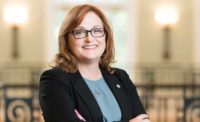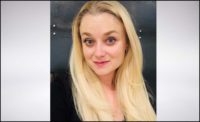Name: Adrienne Johnson
Age: 26
Title: Project engineer, Point Energy Innovations
Educational Experience: B.S. civil engineering 2014, M.S. civil engineering 2016 — both from Stanford University.
Professional Credentials/Accreditations: Fitwel Ambassador
Organizational Affiliations/Achievements/Awards: Organizations: ASHRAE, USGBC, National Society of Black Engineers (NSBE), Society of Women Engineers (SWE), Engineers for a Sustainable World (ESW), American Association of University Women (AAUW), and the American Energy Society. Awards: Malcolm Lewis IMPACT! Award, USGBC; Change Fellow, Construction for Change; Dean E. Stephan & Charles Pankow Builders Fellowship; MAP (now Schneider) Sustainable Energy Fellow; Krupp Internship Program, Berlin, Germany; and the Stanford Dean’s Award for Academic Excellence.
When did you fall in love with engineering?
I fell in love with engineering when I started working on the Parkwood Technology Centre in Cape Town, South Africa. I worked together with a few other Stanford women engineers, Parkwood Primary School, and Bottomup (a local education nonprofit) to design and build the Net Positive community center over three years. It was the first project that I worked on that had a tangible impact on others, and I was so excited to be able to use my engineering knowledge to help the Parkwood community. Today, the building is providing a comfortable and safe space for the primary school students and people in the community to gather and learn every day. It features passive heating and cooling strategies and natural daylight and ventilation. It also produces enough electricity via its PV array to offset approximately 60 percent of the entire school’s energy use — providing clean energy to a community that is often overlooked and significantly lowering the school’s energy bills.
What has been the most rewarding aspect of working in the skilled trades?
The most rewarding part of my work is getting to see projects that I’ve worked on become a reality. Even more exciting is that because they were designed and built sustainably, they will be able to serve many people for decades to come.
What challenges do women face in this profession? Why aren’t there more women in engineering?
This is a complicated question with many answers, but I think one of the most critical challenges is a lack of representation and allyship in the industry. With so few women at the table, particularly women of color, it’s intimidating to seek opportunities in a predominantly white/male industry. In my opinion, the primary reason there aren’t more women and people of color in the engineering field is because we were systematically denied access to the field until recent decades. The other challenges that I mentioned make it difficult to correct this disparity, so progress has been slow, though it is happening.
Describe what your job entails on a day-to-day basis.
Our MEP design engineering firm focuses on highly sustainable and zero-net-energy buildings. We concentrate on the early schematic design phase when a lot of creative decisions that greatly impact energy use can be made. We then work with design-build contractors, who carry out the full design under our review. Because we focus on the early phases of design rather than spending a lot of time making detailed drawings, I have time to work on a wide variety of projects in various capacities. I regularly perform energy analysis in various modeling programs, including OpenStudio and IESVE. I’ve worked on multiple building electrification and decarbonization studies, demonstrating the life-cycle cost impact of switching from gas boilers to heat pump technology. I’m also starting to manage projects and develop the MEP Basis of Design for a few commercial buildings throughout the Bay Area.
What drives/motivates you every day?
I am driven by my passion for learning and solving problems, particularly ones that relate to promoting sustainability on an environmental, social, and economic level.
Describe the proudest moment in your career.
Two projects come to mind. One of the proudest moments of my career was the day that I learned that the University of California system was going to eliminate natural gas usage from all new building constructed on their ten campuses across the state. I spent a majority of my first few months at Point Energy Innovations working on energy and Life Cycle Cost Analysis to demonstrate the feasibility of switching from gas-based heating to an all-electric + renewables solution. This will ultimately result in the elimination of carbon emissions from their future building stock, and I’m so proud that I got to be a part of the effort.
Also, during graduate school, I spent three years working on the Parkwood Tech Centre in Parkwood Cape Town, South Africa, a zero-net energy community center. I helped develop the building design, raised $80,000 for the project, and spent six months in South Africa managing construction on-site. This was the first project I worked on that had a tangible impact on others, and I was excited to use my engineering knowledge to help the Parkwood community. Today, the building is providing a comfortable and safe space for the primary school students and people in the community to gather and learn every day. It features passive heating and cooling strategies and natural daylight and ventilation. It also produces enough electricity via its PV array to offset approximately 60 percent of the entire school’s energy use — providing clean energy to a community that has been denied quality infrastructure for decades.
What remains on your engineering bucket list — what do you aspire to do that you haven’t done yet?
I’ve only been working for two years, so my bucket list is very long at this point. I would really like to expand the boundaries of who sustainable infrastructure works for, potentially by working on a zero-net-energy affordable housing complex or another center for a low-income community or nonprofit in the U.S.
What’s one thing no one knows about you?
Not many people know that I used to be able to jump over my own head. I was a track and field athlete and competed on the Stanford Varsity team for a few years. I specialized in high jump, and my personal record was 5’10” – my current height.
List any mentors who’ve helped you succeed and describe exactly how they’ve shaped your success.
I can think of so many people that have helped me over the years, and I’m incredibly grateful to all of them, particularly my family, friends, and colleagues. A few key individuals also come up when I think of this:
-
Sarah Billington was my advisor when I was an undergrad studying civil engineering. I’m not sure I would be an engineer today if it weren’t for her. My previous advisor told me that because I was an athlete, I shouldn't study engineering and should instead do something less rigorous. Sarah believed that I could do it and gave me realistic and helpful advice for planning out my classes. She encouraged me to apply for a master’s degree and even a Ph.D because of how much she believed in me. She helped me get my graduate degree completely paid for through a course assistant scholarship and gave me an opportunity to discover teaching, which I really love.
-
Peter Rumsey is the CEO/founder of Point Energy Innovations. I first met Peter when I took his advanced energy efficient building design course during my master’s program at Stanford. After the class, he brought me in for an internship with Point Energy and then ultimately hired me full time. Although he has a million things to do, Peter spends a lot of time working directly with me to help solve problems on my projects and is very patient and thorough whenever I have questions. We have a regular learning session in our office where he does a deep dive into a technical topic, which is one of my favorite parts of the job.
What does the future hold for you?
In the long term, I hope to start my own company. I don’t yet know what that will entail, but I would like it to be deeply focused on sustainable and equitable infrastructure development. In the near term, I’d like to earn my P.E. license. I’m not yet an EIT, unlike most people my age that I know in this field. I studied civil engineering in college, and our program was heavily focused on structural engineering and construction, which is very different from what I do today. I didn’t know anything about the exam at the time, so I didn’t think to take it after I graduated. Now, four years later, I’m very interested in earning my P.E. license in mechanical engineering and am planning to take both exams in the next year.
What advice do you have for prospective female engineers considering entering the field?
I have three pieces of advice: Find a good mentor (or a few!) that will not only give you guidance but will advocate for you, work with and for people who you admire and are passionate about the issues that matter most to you, and don’t be afraid to ask questions. Even if you think you have nothing to add, you’ve probably thought of something that others need to consider.




